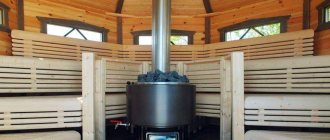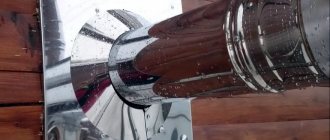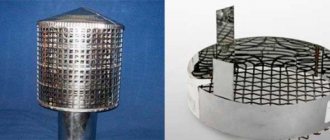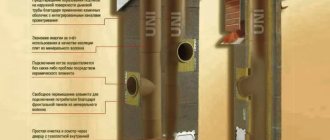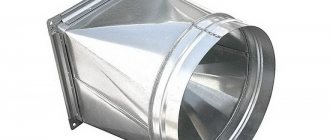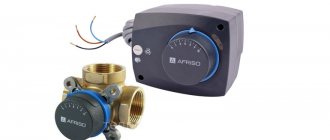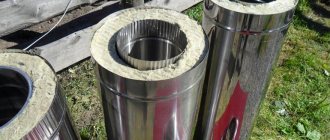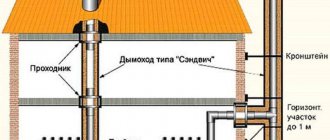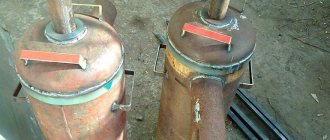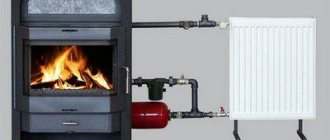In addition to its advantages, individual heating has a significant drawback - the risk of fire. The risk of fire increases significantly when the combustion process reaches high temperatures and fiery sparks fly out of the chimney with great force.
A spark arrester on the chimney will help to cope with this problem - the device prevents the spread of dangerous sparks. The device has a simple design, so it is quite possible to make and install it yourself.
We will tell you how the spark arrester works, describe the features of different models, and provide step-by-step instructions on how to manufacture and fasten the element. The information presented will help you complete all the work yourself, saving money on purchasing a finished product and calling a specialist.
What is it and what is it for?
The spark arrester is designed to extinguish sparks flying out of the chimney when fuel burns in a stove/fireplace.
Usually it is mounted directly on the chimneys of solid fuel stoves, the chimney pipe of a bathhouse, or a special glass for attaching deflectors. This installation is a special nozzle with a metal mesh cylinder and a protective visor on the top.
Main models
The elements of the chimney that ensure the elimination of hot incandescent particles are different. At home, as a rule, two types of spark arrestors are used:
- Stainless steel casing, which is a mesh structure. You can do it using improvised means.
- Deflector. In addition to extinguishing solid hot particles, it improves traction by redirecting the wind flow. Protects the stove device and bathhouse from a dangerous phenomenon - backdraft as a result of strong winds.
The damper in the form of a casing is the most popular, since its design is quite simple. Holes are made in the pipe or a special nozzle in the form of a mesh is attached to it. The disadvantage of this design is the frequent revision of the spark arrester device. Perforated mesh quickly becomes clogged, as combustion products settle on their surface. The higher the degree of contamination, the less draft in the pipe. The spark arrestor, made in the form of a casing, is subject to frequent cleaning. On sale there are assembled casings for extinguishing sparks. Their advantage is their easy connection to the chimney pipe.
More modern devices are spark arresting devices - deflectors. Externally they look more aesthetically pleasing. When using deflectors, the draft in the chimney is not reduced. Such absorbers are equipped with mesh and perforation. Their distinctive feature is the presence of narrowing points, which allow increasing traction inside the spark arresting element. Depending on the location of the narrow sector, there are various models of dampers, many of which are very similar in appearance to the casing, but are more aerodynamic. The disadvantage is that it gets dirty quickly and requires frequent cleaning, especially when using resinous logs as fuel.
Principle of operation
The principle of operation is to limit the free movement of sparks flying out of the chimney. A special design repeatedly redirects the movement of particles that encounter various obstacles.
When hitting a metal mesh with the smallest cells, the sparks are broken, the speed of their movement decreases along with a change in direction of movement. Upon subsequent collision with a metal structure, the particles are extinguished without leaving the chimney.
These filter obstacles do not interfere with the free movement of gas.
Other spark arrester designs
Sometimes bathhouse owners adapt other methods to catch sparks flying from the chimney. The most common methods are:
- A piece of pipe with a welded end is placed on top of the bath chimney. Holes are cut on the side of the head by welding or drilled. Smoke will come out through them.
- The simplest design for a bathhouse consists of a mesh welded inside the head of the chimney. But this option is inconvenient, since over time the mesh clogged with soot will have to be cut out for replacement.
- If the location of the bathhouse is in a windy region, you can install a high-quality deflector on the head of the chimney. In the absence of wind, such a chimney cannot be used due to lack of draft.
- The easiest way is to make a chimney with knees with your own hands. The smoke coming along the bends of the pipe will give off additional heat inside the bathhouse, and reduce the number of sparks flying out.
As you can see, making a spark arrester for your bathhouse with your own hands is quite simple and anyone can do it.
You can see how to assemble a spark arrester in the following video.
https://youtube.com/watch?v=mcL0zx_1jLg
Kinds
There are many varieties of such units. They differ in shape, size and the element itself responsible for extinguishing the spark.
Structurally, these devices may also differ. The following types of spark arresters are most often used in individual heating:
- spark arrester-casing;
- spark arrestor deflector.
Advantages and disadvantages
Speaking about the advantages common to all designs, it is worth noting the unimpeded exit of smoke from the pipeline and the preservation of the original draft. In the case of spark arresters-deflectors, the thrust indicator increases.
The option in the form of a casing or mesh cap is characterized by the simplest and cheapest assembly scheme, as well as the simplest installation.
There are some shortcomings here. For example, this type does not have a deflector umbrella, which prevents precipitation from entering the chimney. The second flaw of such a spark arrester is the absence of a partition that changes the movement of gases along the axis.
Varieties
Currently, there are a huge variety of spark arresters, differing in design from each other, but two types are still particularly popular:
- spark arrester in the form of a stainless steel casing;
- products in the form of a deflector.
The main condition is unhindered traction in the structure. Gases should flow through the chimney pipe easily and not encounter barriers. In addition, the spark arrester must extinguish all sparks coming through the pipes.
The dimensions of these devices can be different, it all depends on the diameter of the chimney. The diameter of the spark arrester can be either 80 mm or 550 mm. The size of the canopy directly depends on the diameter of the connecting pipe that is installed on the chimney. Review the table to understand the relationship.
| Connecting pipe diameter, mv | Visor diameter, mm |
| 80 | 160 |
| 100 | 200 |
| 110 | 220 |
| 120 | 250 |
| 130 | 250 |
| 140 | 280 |
| 150 | 300 |
| 160 | 300 |
| 180 | 360 |
| 200 | 400 |
| 230 | 400 |
| 250 | 450 |
| 280 | 450 |
| 300 | 500 |
| 350 | 550 |
| 400 | 600 |
| 450 | 650 |
| 500 | 750 |
| 550 | 800 |
The operation of a spark arrester on a chimney for a bathhouse or home is very simple. It is worth saying that all types of these products function completely similarly:
- Combustion products move through the smoke exhaust channel.
- At the tip they are prevented by a spark arrester, which changes the direction of movement along the axis.
- At the exit of the pipe, sparks pass through a mesh that extinguishes them.
Do it yourself or order a device?
Custom spark arresters are a fairly common option. If you trust the contractor, you can count on a good service life and complete serviceability. But this does not always happen, especially if the manufacturer decides to save on material.
If you decide to make your own spark arrester, it may take you longer. At the same time, you will be able to fully control the process, from the selection and acquisition of materials to design nuances.
Tips for choosing
When choosing, you should pay attention to the dimensions of the pipeline, the type of construction and the quality of the material. The diameter of the devices is usually 80-550 mm. The dimensions of the canopies depend on the dimensions of the tubular structures that are placed on the chimney.
The most commonly recommended products are stainless steel. Lack of corrosion, durability and affordable price are the main advantages of this solution.
Popular models
There are simplified shell-like options and solutions with a deflector function. Among the latter, the following popular modifications can be distinguished:
- TsAGI;
- Grigorovich's apparatus.
- Round Volper.
- H-shaped device.
- Vane.
- Disc-shaped.
Sparks from the pipe
The key element of the bathhouse is the stove, the correct installation of which determines the quality and service life of the bathhouse. In the process of arranging the stove, you should take care of the safety of all internal and external ceilings, and also be sure to install a spark arrestor on the bathhouse pipe with your own hands.
Information. Assembling this element is not a difficult task, but it is very important, since it is the spark arrester that can one day save your bathhouse from fire.
Of course, there are cases when the spark arrester on the bathhouse pipe does not work at all, and sparks continue to frighten the owners of the bathhouse. This is a rather serious and dangerous problem, the solution of which should not be delayed.
In most cases, it occurs in straight-through pipes with high draft.
In this case, the problem can be corrected only by making a smoke circulation, which will reduce the rate of smoke removal into the chimney.
In addition, the problem may lie in loosely fitting firebox and vent doors, especially if there is no damper on them.
Consequently, an influx of air enters through the resulting cracks, due to which the coals flare up and spark.
Thus, there is a need for some reconstruction of the furnace. Also, it is necessary to directly monitor the kindling process, since many people do it incorrectly.
Information. The fewer bends and turns in the chimney design, the less likely it is for sparks to occur.
Step-by-step production and installation of a spark arrestor with your own hands
Let's consider a step-by-step option for manufacturing a spark arrester with a deflector umbrella, consisting of a body, a mesh structure and a deflector cap.
Required materials and tools
To assemble such a spark arrester yourself, you will need the following tools:
- measuring instruments (centimeter tape, level, etc.);
- screwdriver, clamps, pliers and hammer;
- rivets in a set or welding machine;
- metal scissors, grinder, drill and drill bits.
Consumables are selected purely individually depending on the type of device.
Drawing and diagrams
Here is an example of assembling a simple spark arrestor based on a general basic drawing.
Let us identify the main components and at the same time tell you how to make them:
- A cylindrical pipe is a glass that will be placed on the chimney pipe. For manufacturing you will need a metal sheet. We cut out a rectangle from it with a length equal to the length of the circle lying at the base (Fig. 2).
You can calculate the required dimensions using the formula: “L = π × D”, where L is the length, π≈ 3.14, and D is the required cylinder diameter. We carefully bend the resulting strip using a pipe, for example, into a cone, align the edges, drill several holes on them and fasten them with rivets.
- Metal mesh is a network with cells. It is best to purchase a ready-made stainless steel mesh base. The cylinder based on it is made according to the same scheme as the glass.
- Protective cap-umbrella - the main thing here is to correctly cut the cone pattern. To do this, we calculate the required radius of the workpiece using the formula: “C = √ (h² + (D/2)²)”, where C is the length of the side component of the cone, h is the required height, D is the diameter. Carefully roll the finished cut out reamer into a cone (Fig. 3)
- Racks for connecting parts into a single structure are made of the same sheet metal. (Fig. 4) The length of the racks is determined by the dimensions of the structure, taking into account the required margin at the bottom (approximately 20 mm for 1-2 rivets for fastening to the glass). It is better to place these elements at an angle to the vertical - from the pipe to the edges of the umbrella.
Now about the assembly. We attach the stands to the “glass” pipe with 1-2 rivets. We insert a mesh cylinder into the space between the support posts so that it fits slightly into the lower pipe and rests against the cone. Now we expose the fungus - we bend the mounting pads of the racks so that they fit snugly against the inside of the cone. We drill through holes through the posts and umbrella, after which we finally fix the entire structure.
Size calculation
Before starting work, you need to measure the dimensions of the chimney, according to which sketches of the device will be displayed.
It is important to pay special attention to the diameter of the plug - the cross-section should be slightly larger than the diameter of the chimney.
It is equally important to determine the correct size of the cells - they should not be more than 5 mm.
Installation video
Installation features
Proper installation depends on the size of the device parts. If there is the slightest discrepancy between the diameters, it will not be possible to install a spark arrester on the pipe. A welding machine is used to connect individual elements. The joints resulting from welding must be thoroughly cleaned. For final fixation you will need rivets or brackets.
Application
The most critical situations in terms of the possibility of triggering a fire, the required locations, and the organization of installation of spark arresters are set out in the PPR - an official document regulating the fire safety regime in Russia:
- The management of enterprises and organizations is obliged to ensure the good condition of spark arresters/extinguishers installed on heating, process equipment, and smoke removal system shafts in case of fire.
- It is prohibited to operate tanks, special vehicles for transporting flammable liquids, flammable liquids, gas cylinders, and other dangerous goods that are not equipped with spark arresters that are in good condition.
- Chimneys of mobile drying units used for preparing grain crops must be equipped with spark arresters.
- It is prohibited for vehicles not equipped with spark arresters to enter the territory of a gas station during refueling and fuel receiving operations.
In general, the management of motor transport, agricultural enterprises, heads of local administrations of settlements where stove heating of residential buildings and outbuildings predominates is obliged to organize monitoring of the presence and serviceability of spark arresters, because This is what determines whether fires will break out in the jurisdiction for such a reason.
In turn, each owner of a private residential/country house, bathhouse/sauna must ensure the safe operation of heating/kitchen units/facilities - stoves, fireplaces, boilers, barbecues, barbecues, because any such device that processes solid fuel, emitting hot combustion products into the atmosphere, poses an increased fire hazard. This is especially true for owners of residential and ancillary buildings made of combustible building materials, as well as in the presence of such buildings, as well as roofs made of flammable materials in neighboring areas.
This applies to both the construction of new buildings and the operation of existing buildings, especially since the costs of purchasing and installing spark arresters on chimneys are not so significant, and maintenance, which consists of periodically/if necessary cleaning of grids/grids from accumulated soot and ash, is not presents particular difficulties.
A spark arrester for a barbecue, barbecue, bathhouse, summer kitchen or country house is an example of how a fairly simple technical device can not only make living and outdoor recreation comfortable, but also ensure the safety of people.
A spark arrester certificate is mandatory documentation, along with a technical passport and installation and operation manuals, attached to the finished factory product upon sale.
Buying homemade products or making your own spark arresters on the advice of “gurus” from the Internet is fraught with both loss of money, time and nerves, and failure to achieve the set goal due to the products’ non-compliance with the design requirements of the standards, the quality of the parts and materials used.
Maintenance and care
The complexity of maintenance depends on the selected device model. In general, for all options, proper operation of such a device comes down to periodically cleaning the grid from soot.
If we are talking about a deflector with a “skirt”, you will need to periodically check that insects, leaves and other small debris are not blocking the openings for removing rain and melted snow.
How to paint iron
Bathhouse owners are constantly faced with rust.
Of course, it is best to make tanks and other stove components from stainless steel, but in the absence of such an opportunity, various paints and varnishes will come to the rescue.
So, how to paint a sauna stove? It is best to opt for heat-resistant silicone enamel.
Some of its varieties can withstand temperatures reaching 600-700 degrees.
Heat-resistant silicone enamel is completely unaffected by moisture and sudden temperature changes.
Therefore, if you want to protect the stove in your sauna from corrosion, heat-resistant silicone enamel will become an indispensable assistant in this matter!
Expert advice
Distance from chimney to spark arrester
The mounting height of the cone must be within the minimum permissible values so that the design does not disturb the draft and at the same time prevents debris and precipitation from entering the pipeline from the outside. To calculate the required parameters, we recommend using the following table:
| D, mm (chimney diameter) | W,mm (visor width) | H,mm (height to chimney) |
| 120 | 240 | 144 |
| 140 | 280 | 168 |
| 200 | 400 | 240 |
| 400 | 800 | 480 |
| 500 | 1000 | 600 |
Causes of excessive heating of the chimney pipe
Quite often it happens that the chimney pipe heats up to incredibly high temperatures.
This entails danger, since the risk of fire increases several times!
In order to minimize it, you first need to isolate all combustible elements nearby.
Next, the insulation is laid around the chimney pipe.
This must be done without fail, since without a high-quality thermal insulation layer around the chimney, you risk your life and health every day.
The reason why a sandwich pipe heats up in a bathhouse also most likely lies in the heat-insulating layer. It may have worn out over time and needs to be replaced with a new one. If the new sandwich structure overheats, a defect from the manufacturer cannot be ruled out. This product also needs to be disassembled and the insulation layer replaced.
So, let's look at the main reasons for the problem:
- The chimney is made of a single-walled metal pipe without a heat insulator, which is completely unacceptable. It is imperative to replace single-layer chimney sections with sandwich pipes, or simply supplement them with a heat-insulating layer;
- There may be errors in the design of the sandwich pipe. It should be remembered that this design is installed in such a way that condensation formed inside cannot reach the outer surface of the chimney.
